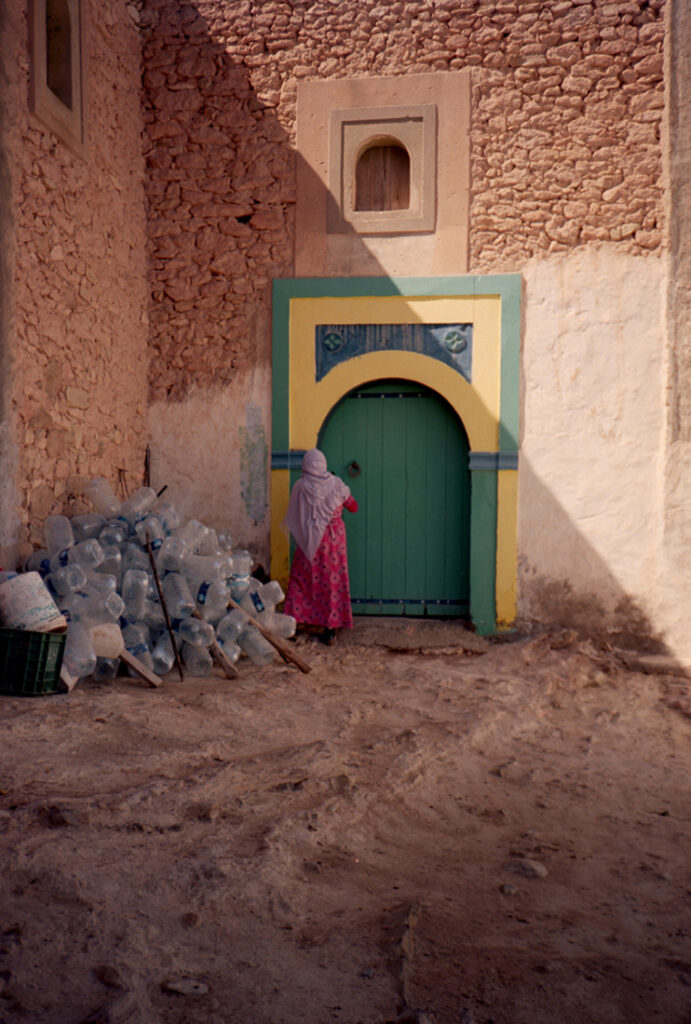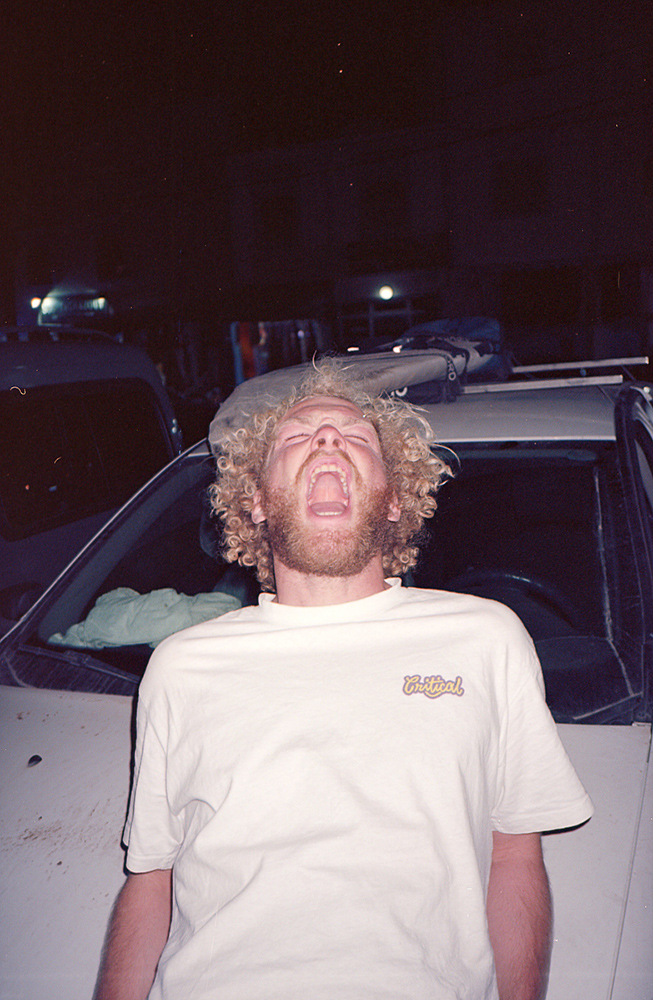Colin Kolmel is a photographer, writer and activist. His photography and writing tell stories of captivating places, impactful people and moments from his journeys. He specialises in conservation and outdoor photography and works across the mediums of 35mm film, 120mm film and digital. As an activist he is striving to raise awareness for ocean pollution and to conserve vital coastlines.

Excerpt from “BARBARY SLIDE”:
I was struck immediately by the balance of opposites upon arrival in Morocco. Businessmen in expensive suits are picked up in black, air-conditioned Mercedes limousines while locals are piled up like sardines on public buses, simmering under the relentless African sun.
Real estate developers are building holiday villas and resorts at a rapid pace, meanwhile around 18 percent of Morocco’s population live in poverty without any access to social security or health care measures.
But what did I expect? Morocco was founded on the balance of opposites with ski resorts and Berber culture in the Atlas Mountains, Bedouin camps in the Moroccan desert, empty wild beaches on the Atlantic coast of the country and the colourful beauty of the Medinas attracting tourists from all over the world.
Despite of the unfathomable beauty of the Moroccan landscape, there are a multitude of issues boiling under the surface, most of them rooted in the consequences of free trade agreements and World Bank loans.
“Barbary Slide” tells the story of merchants dealing with goods donated by the West, farmers struggling to make a living and locals trying to fight plastic pollution.

Enter Agadir. We make our way to Souk El Had, the biggest market in Agadir including 6000 small shops neatly divided in appropriate sectors. Meat and vegetables don’t mix, neither do clothes and furniture. Upon entrance, the souk swallows you whole and spits you into an olfactory overload of strange scents, vibrant colours and the constant barking of the merchants. It would take foreigners months if not years to work out the intricate, labyrinth-like structure of the souk.
While the main purpose of the market is to provide distinct products in clearly separated areas of the market, it is also a place that brings the locals together. They chat and laugh, argue and shout. Somehow the whole scenario has seductive powers. It draws you in. You want to know what’s behind the next turn in the labyrinth. After spending about 30 minutes exploring the different layers and sections of the market, we pass a second-hand clothing store. When browsing through the chest high stacks of folded jeans, trousers, T-shirts and jumpers, I stumbled among many items with prints like “Greenfield Girls Softball” or “Mayfair’s Big Kids Baudouin”.
So, I decided to ask the shop owner about the origin of the garments. He says he doesn’t know. I reply by asking him where he buys his inventory from. The shop owner says, I don’t know before quickly turning his back on me to start a conversation with another man. Very odd.
We leave his shop, I take a couple of photos inside the market, which has proven itself to be fairly difficult. Most locals don’t want their photograph taken.
A local friend informs that it is because they are afraid that their image is going to spread on social media and the internet.
We visit another second-hand clothing store that looks a bit newer and has labelled prices, an uncommon sight in the souk. Despite the more professional appearance it also mainly sells items that look like donations to me. The owner of the store, a young Moroccan man in his late twenties speaking impeccable English, approaches me with a big smile on his face and asks me to take a picture of him and his employees. I take a few shots before he hands me small paper note with his WhatsApp number scribbled on it. We shake hands and laugh. Just before leaving the shop I lean over and ask him if he can tell me where he buys his inventory from. His grin gets bigger. He says that he buys the clothes from warehouses that process European donations to Africa before they get shipped to people in need. For “very little money”. We thank each other and shake hands again. We leave. On our way out of the souk, we pass several dozen other shops just like the one we just left.
Later I understand that most cities and even villages have stores and markets that buy donated clothes in bulk before the donations get distributed to where they are needed.
Upon that discovery one must ask themselves how much is left for the people who rely on these donations. Probably only a fraction of what they need to cover their basic needs.
It feels strange to think that all these abandoned items were once fashion choices. Choices made by us.

Tiny pink ballerina shoes with sparkly studs on them, once treasured by a little girl, just a few thousand miles North. They carry a different girl now, skipping over rough boulders, hot sand and barb wire instead of cobble roads, lush parks and crayon hopscotch markings.
A white mini dress with spaghetti straps, in the past worn to accentuate the beauty of the wearers’ physical features. Today it is yellowing and fading on top of pile of clothes in a Moroccan market. Local women pick it up, give it a swift look and quickly abandon it – to be forgotten.
Due to a difference in faith and culture, our fashion choices are not appropriate to where we donate them to.
By wearing a revealing dress or a skirt that ends above the knee or even not covering her shoulders, a local woman can quickly make herself a target.
Even though, the dress itself is a beautiful garment, it is not appropriate or save to wear in most places. This shows that a fashion item, if it does not correlate with the socio-cultural environment and the needs of the person wearing it, becomes useless. Undesirable even.
This is also a result of free trade agreements, as most local Moroccan manufacturers cannot deliver products at the price Chinese suppliers can or bring their costs down to what it costs to buy donations. Furthermore, most local producers do not have the cashflow to benefit from the export-oriented development adjustment measures enforced by the IMF, financed by the World Bank. Therefore, they get pushed out of their own market without the financial means to pay for export distribution of their merchandise.

Luckily, not all is lost just yet. In order to preserve the stunning beauty of Moroccan nature, we must understand that our consumer behaviour has a direct impact on everyone involved in the production, distribution and disposal of the products we purchase there. While it might sound overwhelming or scary, changing our patterns as consumers holds huge potential.
Changing not only what we buy but why we buy it, is an easy way to make a long- lasting improvement on the health of the environment.
Additionally, we need to agree that every inch of unspoiled nature is worth preserving and make more responsibility decisions on how we manage the natural resources that we are already using with an aim towards restoration. The Moroccan government might not take conservation efforts seriously and the public might be largely uneducated on the effects and causes of climate change, but we have the knowledge, means and responsibility to act.
Not only on the home front but on all fronts.
If you choose to accept this responsibility and act accordingly, you will encounter a beautiful mix of European, Arabic, African and Berber culture.
While most of us cannot take on governments individually, we can make a difference through our daily behaviour, especially when abroad. Choose the local farm stand on the side of the road over the Moroccan supermarkets. If you see trash in nature, take it with you and dispose it properly. Reduce your use of plastic packaging to a minimum. It all comes down to necessity. What are necessary steps we can take to regenerate nature? On an individual basis, it comes down to small behavioural changes like the ones mentioned above.
Morocco is far too diverse and wild for its beauty to be overshadowed. We are advocates for change.
Thank you, Morocco.